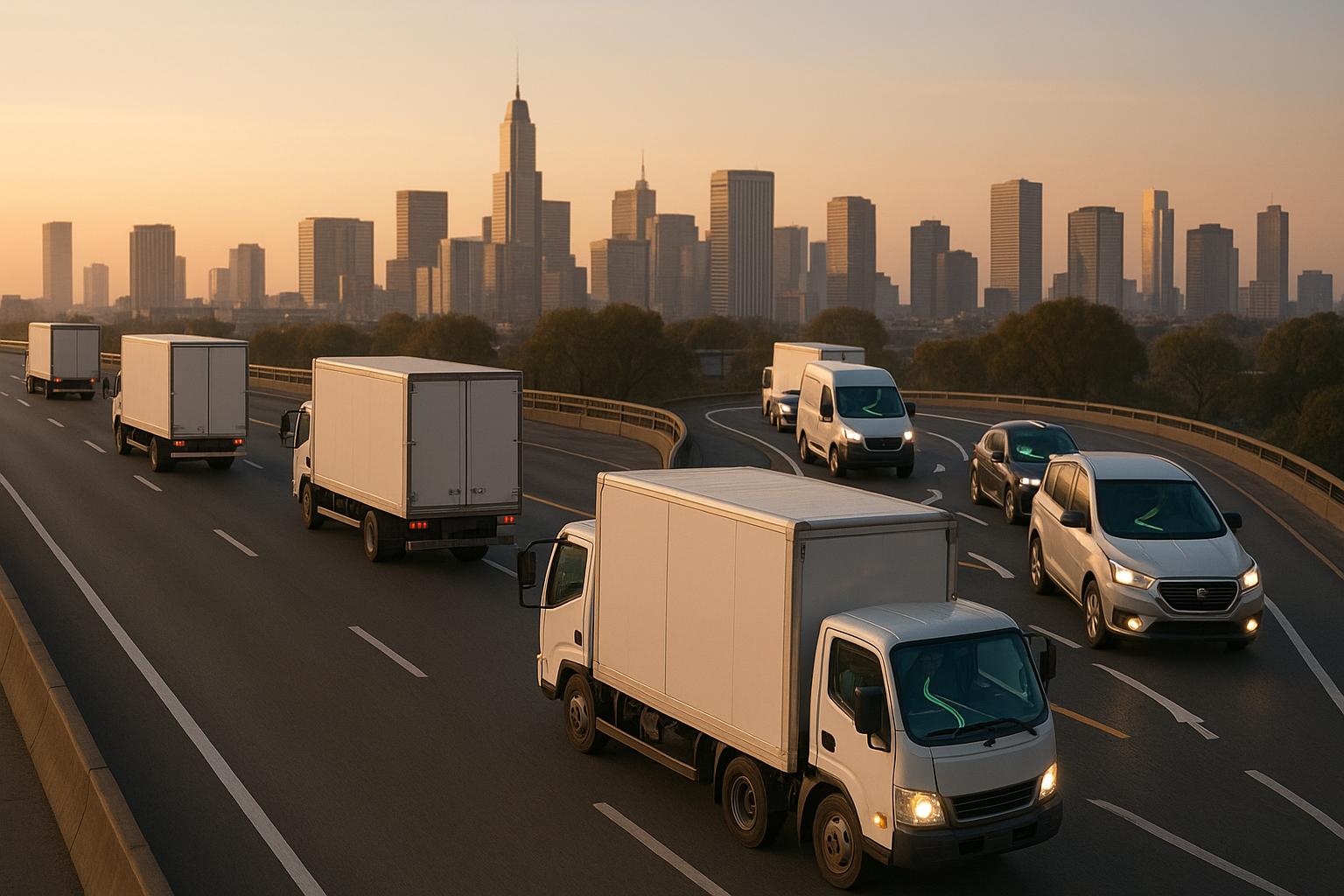AI can cut travel time for service teams by up to 20%, boost daily job capacity by 25%, and reduce fuel costs by 30%. Here's how:
- Smart Route Planning: AI considers traffic, weather, and schedules to create the fastest routes, saving up to 40% travel time.
- Live Traffic Updates: Real-time data helps teams avoid delays, cutting average incident-related delays by 12-18 minutes.
- Smart Scheduling: AI groups jobs efficiently, reducing downtime by 25% and improving productivity.
- Mobile Route Changes: Dynamic updates adjust routes instantly, even in emergencies, saving 15-20% on travel time.
- Multi-Stop Route Optimization: Systems like UPS's ORION save millions in fuel and shorten routes for better efficiency.
AI also outperforms manual planning by reducing route planning time by 95% and improving accuracy by 13-18%. These tools are transforming field operations, making teams faster, more productive, and environmentally conscious.
Using AI to Optimize Delivery Routes
1. Smart Route Planning
AI-driven route planning is changing how service teams handle their daily schedules by processing multiple factors at once. Unlike old-school static routes, these systems use real-time data to create routes that cut down on travel time. This feature lays the groundwork for many of the efficiencies AI brings to the table.
These systems take into account:
- Traffic conditions (both current and forecasted)
- Historical traffic trends
- Weather conditions
- Road restrictions and types
- Technician skillsets
- Appointment time windows
- Parking availability
For example, a Chicago-based HVAC company using AI routing managed to boost the number of service calls per technician from 5 to 7 daily while slashing travel time by 40%. On average, AI routing systems can deliver:
- A 15-30% cut in mileage
- A 25% jump in daily service capacity
By learning from past service times, traffic data, and successful routes, these systems get smarter over time, fine-tuning route accuracy with historical data.
When emergencies arise, smart route planning becomes a game-changer. The AI quickly identifies the closest qualified technician and adjusts routes for the entire team in real time. This ensures efficiency is maintained while the emergency is addressed. This ability to adapt on the fly ties directly into the live traffic analysis we'll explore next.
2. Live Traffic Updates
AI-driven live traffic updates are transforming how service teams manage their routes. By analyzing billions of GPS data points daily, these systems offer up-to-the-minute traffic information across vast road networks. For example, Iteris' ClearData™ engine tracks 3.8 million miles of road in North America, delivering real-time data that helps teams sidestep delays before they disrupt schedules.
These tools pull from live data sources to instantly reroute teams when disruptions arise, finding better alternatives within seconds. This quick response reduces average delays of 12-18 minutes per incident.
One standout example is a Canadian beverage distributor, which achieved a 98% on-time delivery rate despite navigating Toronto's notoriously congested highways - all thanks to AI traffic updates.
AI doesn't just react to current traffic; it also uses historical data to predict patterns of congestion. This allows service teams to:
- Adjust departure times to steer clear of rush hours
- Choose alternate routes that might cover more distance but save time
- Offer precise ETAs by accounting for expected delays
This predictive power works hand-in-hand with AI's scheduling capabilities, which we’ll dive into next.
3. Smart Scheduling
Smart scheduling takes AI-driven traffic predictions to the next level by coordinating teams based on current conditions and upcoming constraints. By analyzing both real-time and past data, these systems create schedules designed to cut down on unnecessary trips while keeping productivity high.
AI schedulers use historical trends, live traffic updates, and technician expertise to group nearby jobs efficiently. This approach respects time windows and has been shown to reduce employee downtime by 25%. Key factors considered include:
- Travel time estimates between job locations
- Job complexity and duration
- Technician skills and availability
- Geographic proximity of appointments
When disruptions happen, the system quickly adjusts schedules without increasing travel time. These instant updates ensure emergency responses remain effective, as discussed in Section 1, while maintaining overall efficiency.
This scheduling system connects seamlessly with live GPS tools and traffic data, as covered in Section 2. By integrating GPS tracking, traffic updates, and weather forecasts, it provides accurate travel time predictions and helps teams sidestep potential delays before they happen.
sbb-itb-7020db0
4. Mobile Route Changes
AI-driven scheduling gets even more practical with mobile route optimization, allowing technicians to adjust routes in real time. This hands-on approach ensures that AI's planning translates directly into saved time and effort during the workday.
With AI-powered mobile apps, routes can be updated instantly by analyzing live traffic, road closures, and schedule changes. These systems process an impressive 3.8 million miles of road data in seconds, recalculating the best paths while considering technician expertise and appointment commitments.
Here’s what these systems offer:
- Voice-activated rerouting for hands-free adjustments
- Dynamic schedule updates to keep plans current
- Emergency prioritization to handle urgent tasks first
- Push notifications for route changes and updated ETAs
Companies using these tools have seen travel times drop by 15-20% and fuel costs cut by 30%.
Even in areas with weak internet, modern AI routing apps ensure technicians stay on track. They rely on cached data to provide accurate route suggestions without disruption.
This approach ties everything together, turning planned routes into practical, real-time navigation. By working seamlessly with smart scheduling (Section 3) and live traffic systems (Section 2), it creates a multi-layered system designed for maximum efficiency.
5. Multi-Stop Route Planning
AI takes the challenge out of planning multi-stop service routes by analyzing several factors at once. It processes location data, appointment windows, and service durations to create the most efficient sequence of stops. This builds on real-time adjustments (Section 4) and predictive traffic insights (Section 2) to keep operations running smoothly, even across dozens of daily stops.
A great example is UPS's ORION system, which evaluates 250 million address points daily. This system has helped UPS save 10 million gallons of fuel each year and cut costs by $400 million annually by shortening routes. These savings also reduce drive hours - an essential factor for service teams managing tight schedules.
Using the routing principles mentioned in Section 1, AI continuously refines multi-stop journeys by factoring in service locations, appointment times, and traffic conditions. It can automatically reroute in real time, adapting to delays without missing appointments. For instance, if a service call takes longer than expected, the AI rearranges the remaining stops to stay on track.
AI can test thousands of route combinations in seconds, balancing traffic and scheduling constraints. When paired with smart scheduling (Section 3) and live traffic tools (Section 2), this optimization allows teams to handle up to twice as many calls per day compared to manual planning.
AI vs Manual Route Planning
AI drastically reduces the time needed for route planning compared to manual methods, turning theoretical efficiencies into practical, daily time savings. For example, while dispatchers might spend 2-3 hours each day planning routes for 10-20 technicians, AI systems can complete the same task in just 5-10 minutes. This means teams can redirect hundreds of hours annually to focus on customer service and other strategic activities.
Here’s a quick look at how AI stacks up against manual planning:
| Metric | Manual Planning | AI Planning | Impact |
|---|---|---|---|
| Daily Planning Time | 2-3 hours | 5-10 minutes | 95% reduction |
| Route Accuracy | 80-85% | Up to 98% | 13-18% improvement |
| Emergency Response Speed | 15-30 minutes | Under 1 minute | 98% faster |
In a 2023 rollout, Coca-Cola Hellenic Bottling Company reported 18% faster deliveries and a 7% reduction in mileage within just six months of implementing AI.
AI systems can analyze multiple constraints at once, something manual planning struggles with. While human planners typically juggle only 2-3 factors, AI handles far more, ensuring decisions are consistent and free from bias. Unlike manual planners who might unintentionally favor certain technicians or areas, AI applies uniform criteria, leading to fairer workload distribution and improved service quality.
AI also scales effortlessly. Adding more technicians barely affects processing time, whereas manual methods experience exponential delays as teams grow. This scalability directly complements the productivity gains discussed in Smart Scheduling (Section 3).
Handling last-minute changes is another area where AI shines. Adjustments that could take 15-30 minutes to rework manually are resolved in seconds with AI. This aligns perfectly with the emergency response capabilities highlighted in Smart Route Planning.
Conclusion
Integrating AI into service operations delivers measurable outcomes. For instance, a utility company boosted technician productivity by 35% using AI-driven scheduling and routing tools.
By combining features like smart scheduling (explored in Section 3) with predictive traffic analysis (covered in Section 2), AI introduces efficiencies that manual methods simply can't replicate. These advancements stem from the five AI capabilities discussed earlier, reshaping how teams manage their daily tasks.
AI's mileage optimization also brings environmental benefits, cutting carbon emissions by up to 18% annually. This reduction is comparable to removing 12 service vehicles from the road each year. These results are directly tied to AI's ability to streamline multi-stop routes (Section 5) and adjust routes in real time (Section 4).
The data makes it clear: AI-powered solutions for managing service team travel aren't just an upgrade - they're a game-changer for modern field operations, delivering operational improvements alongside environmental benefits.


